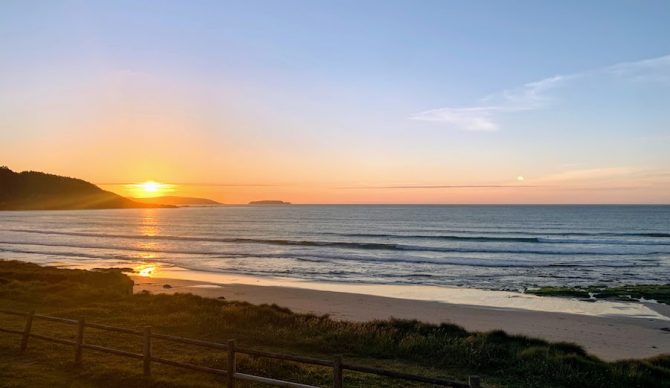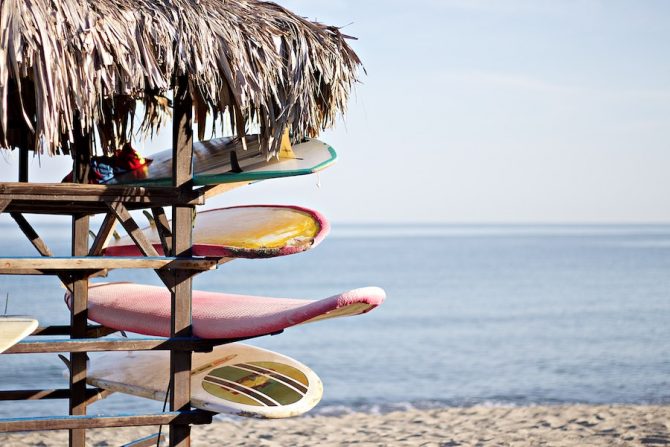
If your plane looks like this, at least you’ll be able to have a few words with the baggage handler before he touches your board. Photo: Unsplash
With international travel opening up again, and plenty of cabin fever (and probably some savings too) after more than a year at home, we’re starting to look farther afield than our local break in search of waves. But with surf travel comes the ever-painful dilemma of “what the hell do I do about my surfboard?” Either you bring a board with you, resulting in airline fees, potential loss/damage to your favorite shred stick, and the pain in the ass of carrying a surfboard wherever you go.
Or you find one on location and submit to the whims of the local surfboard market. Buying a board can be fun, and connect you with the local surf culture, but it’s a time-consuming process and comes with plenty of potential complications. Renting should only be an option if you’re traveling with family and just hoping to get a surf or two in. If you decide to rent, you’re subjecting yourself to subpar equipment, hourly pricing, and the pain in the ass of finding rentals.
On a recent trip to Galicia, Spain, I made the choice to buy a used board there instead of bringing a board with me, traveling across the pond with just a wetsuit, leash and two sets of futures fins that I didn’t use once. Once there I ended up giving in to the convenience of renting, and learned a lot (mostly through trial and error) about the factors at play in the decision of bringing or sourcing a board over the course of my month sampling the tasty waves along this stretch of European coastline. Here’s some of what I learned, in the hopes that during your upcoming surf travels, you might make a more informed decision than I did.

Small (but tasty) Galician rollers by sunset. Photo: Will Sileo
Factors to Consider
How long will you be there/how much will you be surfing?
For me, as a 20-something part-time writer, I’d describe myself as “budget-conscious.” In other words, I don’t have any desire to blow $150 or more on surfboard transport fees just for a couple days of surfing. If I’m going on a family trip and taking a few days before or after to snag some waves, I’ll happily trade subpar equipment and daily rental fees for the convenience of not traveling with a board. But if I’m hoping to do more than one or two days of surfing, bringing or buying a board makes a lot more sense.
Staying in one place or moving around?
This is a big one. Flying with a board can be scary and expensive, but trying to grab a taxi, take public transport or just walk around town with one in addition to your other bags can be downright impossible to achieve. And if you’re traveling with a group of non-surfers it can suck to be the one saying, “but what about my surfboard?” when trying to make group decisions. On the other hand, finding surf shops that rent and tethering your surf sessions to their operating hours can be a royal pain in the ass.
Availability of boards?
This consideration can very quickly rule out the rent-or-buy-a-board option – if there are no boards where you’re going, bringing a board might be your only choice, unless you want to take up bodysurfing. If you’re going to buy a board there, check your destination’s version of Craigslist a decent bit before you leave. If you decide renting is you, make sure to check out what breaks you think you might be surfing, and if there are any surf schools or surf shops nearby. And check in with said surf school/shop beforehand. Some surf schools will only have softies for you to rent, and some high-end/boutique surf shops don’t rent at all.

Kanoa Igarashi turned up at home with a bag full of broken boards. Photo: Instagram
Bring A Board
The best option for those who hope to do some serious surfing, but there are plenty of downsides that might make you consider finding a board at your destination.
Pros:
– It’s your own equipment, so you know how it works (no first few waves wasted getting used to rental equipment or accidentally buying a shitty used board) it’s there for you the minute you touch down, and (assumedly) it’s a surfboard you like riding.
– If it breaks, you can fix it yourself – assuming you’re handy enough. With the (very high) risk of some type of damage during transit, make sure you’ve got Solarez and know how to use it.
Cons:
– If it breaks and the repair is beyond your skill level, you’re screwed.
– There’s a chance you’ll bring the wrong board – say you’re going mid spring to anywhere in the Northern Hemisphere, and there might be good swells, but you might also need a groveler. Best to pack a bit of an all-rounder.
– If you don’t have a boardbag designed for airline travel, you need to get one (we’ve got a few options listed here). They’re expensive, but it’s a lot better than receiving your board looking like the above.
– Traveling with a surfboard is a royal pain in the ass. They don’t fit in cabs, only sometimes fit under the bed, and you can end up paying more than the board is worth in airline fees, especially if you plan on taking flights in between surf locations. Which brings me to option two…

“Amazing Stringerless Handshaped Eco Surfboard” It could be yours for the low, low price of $550! Image: Craigslist
Buy A Board
This is what I had planned on doing when I came to Galicia, but then failed to do so and gave in to the convenience of renting. Basically, by the time I had decided this used Firewire I saw in a shop was out of my price range, and went on to look for other boards (with a very narrow set of options because I stubbornly wanted a board that fit the futures fins I had brought – fun fact, FCS rules Europe), I had already rented a few times and slowly gave into the convenience of it. A sad downwards spiral if you ask me.
Pros:
– Buying a board is easily my favorite kind of shopping. I do it all the time in fact. What better way to spend your vacation time in an exotic destination than trawling the local version of Craigslist? (I’m only being slightly sarcastic here).
– In such interactions with the local community you get a chance to connect with surfers from a different country and learn about the waves you’re going to be surfing, etc., etc.
– If you’re not too picky about your equipment, you can just buy a beater board, bang it around a bit, and then dump it on the side of the road for the price of renting a board for a week. Don’t actually dump it on the side of the road, any surfboard (and the planet) deserve to be treated better than that.
– Buying a beater board means any repairs you do don’t even need to be the most watertight, especially as you get towards the end of your trip.
Cons:
– Buying a board is a time-consuming process. You’ll be spending valuable surf time board shopping and it could be a solid few days to a week before you find something you like. All the more so if you choose to go the used board route as you’ll first have to get your bearings navigating the used board market in a different country.
– You could accidentally buy a piece of shit. Craigslist/used board sales are often a dodgy process. Make sure to check and double check the finboxes (put the fins in, and take them out) strip some of the wax off to check for horrendous pressure dings, and don’t trust stickers (there’s a 50/50 chance a ding is hiding underneath it).
– What are you supposed to do with it after? I wish I had a conclusive answer for you. Maybe you bring it back home if it really sang to your soul, or you could give it to a stoked grom, surf school, or local friend. Selling it is possible, but difficult (see: language barrier) and not a sure thing by any means. Posting it for dirt cheap helps if you’re okay not getting all your money back, as does noting on the listing that you’re moving and can’t take it with you – but beware the lowballers.

Nice view, but I wouldn’t want my rental options to look as weathered (or as long) as these boards. Photo: Joey Pilgrim//Unsplash
Rent A Board
I hesitate to suggest this as an option because, after this trip, I think I may never rent again. Living in Santiago de Compostela, I was an hour or more away from the coast, and either caught rides with a friend or took public transport to the waves. Because said friend with a car also had a board for me to borrow (cheers, Lucas), and I planned on surfing infrequently while there, I ended up renting whenever I went searching for waves myself. A poor choice, read on for the cons.
Pros:
– Don’t need to travel with a board at all. Which is nice, especially if you need to take a bus/train to get to the waves.
– Get to try different boards/use different boards for different conditions. If the waves suck, rent a foamie!
– If you break it, you do have to pay for it, but you don’t have to deal with waiting for your favorite board to get repaired.
– Renting can be a great way to connect with local surf shops in the area and get advice on spots and conditions.
Cons:
– Can’t Dawn Patrol – no surf shop anywhere in the world opens before 10 a.m., and in Spain, that’s 10:30 if you’re lucky (the waves weren’t good and the employee was late). And at least in Galicia, surf shops are often closed on Sundays.
– You break it, you pay for it. I rented this old, chunky shortboard the other day, paddled out, and the first wave I went for was an outsider I attempted to late-drop. The board completely failed to hold a rail, I absolutely ate it, and in the tumble hit the fins and blew one of the FCS plugs. A relatively simple repair with the right materials, but it wasn’t my board to fix. Instead, it was my board to pay for, to the tune of 30 euros.
– The rental fees stack up, especially if you hope to surf with any regularity, and especially for a fiberglass board. I paid around 15-20 euros/session, which can make bad waves not worth it or force you to get out when you don’t want to stop surfing because you don’t want to pay another 20 bucks.
– Once you rent the board, you’re on the clock. No dilly-dallying or taking a second to get your wetsuit on. That 15-20 euros a session was often 15-20 euros for just two hours.
– Finding a board, especially at the most remote breaks, can be difficult if not impossible, tying you down to more populated surf spots. And at least in Galicia, the best waves were always the hardest to get to.
– Rental boards aren’t always of the highest quality (in fact they rarely are) and it can take a few waves at the beginning of your session to get used to the new equipment.
Overall, I’d say that bringing a board is your best option if you intend to do some serious surfing. Buy a beater board when you’re there if you want to keep things cheap (or enjoy the process of shopping for surfboards as much as you enjoy surfing). If you’re only going to get a few days of surfing in, renting is ok. But that’s just my opinion. What do you think? Let us know in the poll below.

